20 Social Media Holidays to Celebrate This May
By Yasmin PierreApr 10
Unlock the secrets to staying ahead in the ever-evolving world of social media marketing.
Published October 25th 2016
In the early days of social data, it was all about buzz monitoring. Marketers could watch as the likes and follows rolled in, reporting on their growing reach. But while more social media engagement may increase awareness, these numbers do not provide any real intelligence.
Gradually, marketers realized they were reporting on vanity metrics that weren’t revealing any information that could be acted upon. Tying these numbers to sales or customer satisfaction was nearly impossible.
As the industry has matured, the number of use cases for social data has increased, and the information generated can legitimately be called insights, as they produce knowledge that can be acted on to improve the business and customer experience.
In its infancy, the industry was called social listening – an apt term for the collection of mentions in a passive manner. The more recent switch to social intelligence reflects the maturing methodology and technology that has transformed the discipline into a field of research that can surface actionable insights.

Obviously, there is no point collecting insights if nothing is done with them. What is needed is a change of culture that understands the value of converting insight to action. Instead of waiting for that day to arrive, practitioners have it within their power to influence perceptions of social data and consumer insights.
Vanity saw businesses obsessed with their own brand. A change has been brought about by turning the focus onto what matters: the audience and their behavior. Consumer and market insights can reveal a deeper understanding of the different actors within your audience, and it’s here that the real business-changing insights can be found.
While not an exclusive list, here are some of the most common areas social data can enrich:
Part of the strength of social data is that for all the numbers you can collect on a topic, underneath it all is the voice of the customer. This means that social media research can provide answers to specific questions, but it can also be scrutinized in a ‘follow the breadcrumbs’ analysis.
This methodology involves taking a sample of mentions of your brand or product category and reading through them, tagging each one with relevant categories.
Once the data has been read, crossing these categories can reveal details about audience segments that can help you target specific groups. Detailed buyer personas can be created that give marketers a framework of who to target.

Finding trending topics on social media can help keep your content marketing fresh and relevant. It might also unearth details about the competition if they have a campaign or product that is gaining traction.
You can also monitor negative mentions, giving PR teams valuable time in picking up situations that could develop into a crisis.
Brandwatch features Signals – intelligent email alerts that notify you when there are significant or unexpected changes in your dataset. As this is an automatic process it doesn’t require you to already be monitoring that specific topic.
Influencer marketing has itself gone through a journey which has seen it mature. Whereas in the past brands had a tendency to employ stars that had massive reach but not necessarily any relevance, we are increasingly seeing a shift towards influencers who have smaller but more relevant and engaged audiences. Finding micro-influencers can increase the penetration into relevant audience segments.
Whether it’s customers complaining about faulty products or unwanted features, or people expressing their wishlist, social media can be a rich source of ideas for new product development research.
Getting live feedback via social media is valuable and unique, and an obvious way to transition from insight to action. In fact, one company specializes in sourcing eBay and Amazon reviews to develop products that answer the most common frustrations.

Product feedback on social media can be particularly useful for industries that are one step removed from their customers, such as CPG and consumer tech brands.
Of course, there is no point in conducting this research if the information remains siloed, unseen, or unused. Brands must be able to consume insights as well as produce them. Developing a culture that implements the research, taking insight to action, is perhaps a harder step than finding those insights in the first place.
Some departments – and some personalities – are more comfortable with social data and analytics than others. There can be resistance to overcome, but those working with social data can go some way to proving its worth to others in the organization.
The first step is “creating a common language across the organization” and “educating the consumers of data”, according to Bank of America’s Tracy Bell. Many can be distrustful of the data, so educating them can be an important first step.

Once the methodology is understood, the goals and limitations have to be acknowledged. Remove any disparity between what is expected and what is delivered.
Social data provides value that is difficult to obtain with any other method – but it does have its drawbacks too. This isn’t a problem, every data source has them, but acknowledging this will improve trust and transparency.
Initially, work on goals with short-term benefits. It can be tempting to dive into big, long-term projects that will reveal major insights, but proving value quickly tends to be a better path early on.
Whatever kind of intelligence work you do has to have a short-term payback, at least in the early days. You have to show that you’re providing value on a very frequent basis. That helps build a foundation for intelligence to grow within the company.
Presenting the data in an engaging way. Bringing key insights to the front of the social media report grabs attention and convinces busy people to read on. Including real quotes from real profiles with profile pictures of the customers can be a powerful way of illustrating the real world implications.
You need to make social visible within your company.
You need to make social data a visible part of the company’s reporting. Allow people to understand the volume of conversation about the brand on social.
Once they can see the volume and the real world implications, the culture around social data should gradually change. Build up small wins and it will become obvious that your recommendations are based on solid data. Before too long you’ll be turning every insight to action.
Offering up analysis and data on everything from the events of the day to the latest consumer trends. Subscribe to keep your finger on the world’s pulse.
Existing customer?Log in to access your existing Falcon products and data via the login menu on the top right of the page.New customer?You'll find the former Falcon products under 'Social Media Management' if you go to 'Our Suite' in the navigation.
Brandwatch acquired Paladin in March 2022. It's now called Influence, which is part of Brandwatch's Social Media Management solution.Want to access your Paladin account?Use the login menu at the top right corner.